The LiIon or LiPo battery discharge characteristics curves below are from the stack exchange question here - he gives no source or other information BUT these curves are liable to be generic enough to provide a guide.
Your battery's capacity is 1600 mAh nominal minimum at 0.2C.
You are discharging at 5 mA which is about 5/1600 = 0.03C so you are on the right and high side of the black curve by a goodly way.
According to the curves the battery has provided about 98% of capacity at 3.2V at 0.2C so you can expect that for practical purposes you will get 99%+ capacity from the battery at 0.03C by the time you reach 3.2V.
So you can expect that -
Run time to 3.2V would be about Capacity/I drain, and that
Run time from 3.2V to cutoff would be ABOUT Capacity/Idrain_low x 0.01.
Note that I have not bothered taking off the 1% remaining from the first calculation
In this example:
Run time to 3.2V ~~~= 1600/5 = 320 hours.
Run time to 2.5V ~~~~~~~= 1600/2.5 * 0.01 = 6.4 hours
As others have noted, the latter figure is going to be horrendously ill conditioned.
If you ant some guaranteed reserve you would be advised to about 3.6V which, in this low load case, should give you about the same run time at 5 mA but much longer at 2.5 mA. eg by inspection C3.6V ~~~= 90%
T_5mA ~~~= 1600 x 0.9 / 5 =~ 285 hours ~+ 90 % of previous.
T_2.5 mA ~~~~~~~~~~= 1600 x 0.1 / 2.5 = 64 hours ~+ 1000% of previous
Results will vary with temperature, cycle life of battery, battery quality, phase of moon, number of dead fish for sale in immediate locality and proximate bank holidays.
But this gives you some idea of where to start and an approximate idea of what to expect.

NB:
You are highly advised to stop before 2.5V. You gain very very little - as seen from the above curves - and you shorten the battery life by draining it to the dregs. In this case using eg 3V will make only a tiny difference and will do no harm but an unknown but finite amount of good.
Also of some use MAY be
My answer here
Battery university page re Li battery lifetimes
Solar charging:
Tim Prince said:
- Our device is solar-powered.
It charges in about 7 hours on a day of full sun.
Once fully charged, the device will run for ~330 hours.
With this design, there's almost no chance of it draining below the 2.5V lower limit.
If solar charging, be aware that while there may be 12 or more hours of daylight in summer, there will be fewer hours of equivalent full sun. So, if a battery needs 7 hours of full PV panel output to charge it will not achieve this almost anywhere on earth - the exceptions being locations near the poles in summer or a limited number of other locations favoured by combinations of lattitude, altitude and atmospheric clarity.
An excellent site for determining available "sunshine hours" by season is www.gaisma.com
Here is a table for Chicago, USA.
You get about 6 hours of full sun per day in June and July but only 1.5 hours on an average December day. If you need 7 sunshine hours to charge it will take about 5 December days to do so.

Here is the result for Kabul in Afghanistan
In Kabul in summer you will get 7 hours on an average day in 2 summer months and about 30% of this level in mid winter.
Do not expect to be able to solar-fast charge your product in NY NY in mid winter :-).



